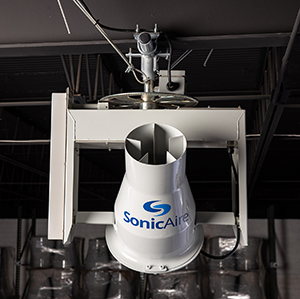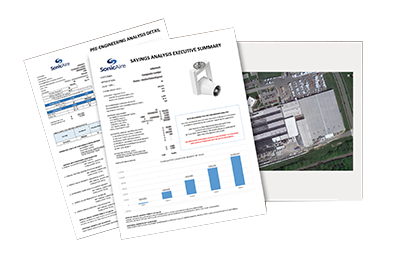If your manufacturing facility struggles with dust buildup, then you already know you need some help. Even if you have a filtration system and dust collection unit, you probably realize it still isn’t enough to prevent dust buildup. If you’re like most facilities, you’re trying to keep up with manual cleanings. But, it’s time-intensive, costly, and honestly, a big pain.
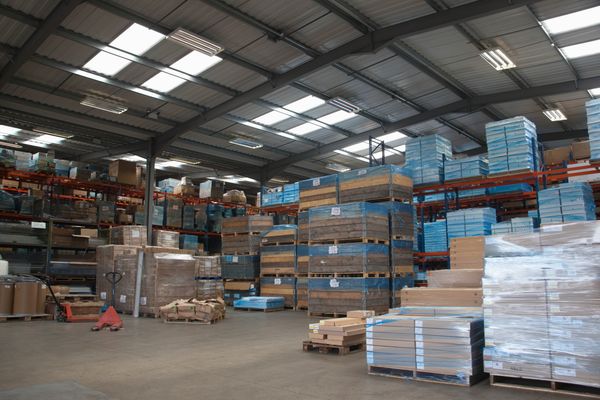 It’s dangerous to let combustible dust sit there, risking potential disaster. Even if the worst doesn’t happen, you’re still at risk for OSHA violations or hits from your insurance company. There are several potential solutions, but easily the most automated approach is to install dust control fans.
It’s dangerous to let combustible dust sit there, risking potential disaster. Even if the worst doesn’t happen, you’re still at risk for OSHA violations or hits from your insurance company. There are several potential solutions, but easily the most automated approach is to install dust control fans.
Not only will you be able to remove the combustion risk of dust buildup, but you’ll also avoid those costly clean-ups.
Hiring a crew to vacuum the dust can cost tens of thousands of dollars per cleaning, you may need to do it multiple times a year, and you’ll need to schedule another in no time. Handling cleaning in-house saves you some money, but you’ll likely need to pull resources away from maintenance or production to complete the task – possibly even halt production during the process. Which probably means you aren’t saving any money at all.
Dust control fans prevent the fugitive dust from traveling up into overhead spaces, ensuring it never has the opportunity to accumulate. Then it’s easily swept up off the floor as part of your crew’s regular daily clean-up.
But how many fans will you need?
Yes, you’ll probably need more than one fan. As far as exactly how many more, it just depends on a number of factors. To know how many fans are needed, you’ll need to take those factors and apply them to your situation.
General Range of Performance
Without a careful look at your facility and analysis of the environment, we can’t give you the be-all, end-all answer on how each fan will perform in your specific facility. However, we can help you estimate it by giving you the range of our fan’s optimal reach.
Typical Range
Because each fan oscillates and rotates in a zig zag, circular pattern, the range is a circle extending out from each of our fans. So, we talk about our fan range in terms of a radius. Each fan has a radial range between 25 and 60 feet. When calculated, this leads to a typical coverage area of between 2,000 and 11,000 square feet.
Average of 7,000 sq ft Per Fan
As a general rule, we say each fan covers roughly 7,000 square feet. Again, you have to remember that this number is a ballpark estimate. Your facility has unique circumstances and limitations that our specially-trained engineers will account for in their design to ensure you’re getting the most effective system possible.
 Three Factors that Determine Just How Many Fans You’ll Need
Three Factors that Determine Just How Many Fans You’ll Need
Each fan has an optimal reach, but there are a few factors to consider that determine how close to “optimal” each fan is able to perform in your specific setup. Don’t sweat this detail; that’s our department.
1 – The Type of Dust You’re Producing
Not all dust is created equal. Particulate size and moisture content vary, and each dust type varies in its ability to travel and accumulate. Different materials produce different types of dust, but even more than that, facilities may produce different dusts at various stages of production.
For example, wood production facilities deal with saw dust. When a log comes into a sawmill, the dust has a large particle size, is moist, and very sticky. This dust doesn’t travel as easily, so while you won’t have it traveling into your rafters as quickly, its stickiness makes controlling it a bit more difficult. At the end of production, sawdust is dry and fine – and migrates so easily that it’s virtually impossible to contain. Chances are, we’ve experienced your type of dust, and know what to expect regarding the performance of our fans in your environment.
2 – The Layout/Operation of Your Specific Facility
We don’t have to tell you that your facility is one of a kind.. However, it’s more than just how important it is to you that makes your facility unique. No two building layouts are 100% identical, and when it comes to dust management, there are even more aspects that complicate fan placement. If you want to get a good idea of what your fan performance will be, though, you should consider the following two factors in your ballpark figures.
A shadow effect diminishes some performance.
So what is the shadow effect? It’s a blockage due to a building structure in your facility. This can be equipment, ductwork, floor-to-ceiling shelves, stairs, or corners in your floorplan’s layout. You may not have initially considered it, but if there’s something blocking airflow from the fan, it won’t mitigate dust buildup behind the structure. Fans can’t penetrate walls, after all.
Environment plays a big role in performance.
The layout of your plant isn’t the only limiting factor on the performance of your dust control fans, though. A facility with cool, arid conditions does not see the same fan performance as one with high heat and humid air. The differences in those environments will impact the third factor: which fans are right for your facility and processes.
At SonicAire, we have experienced engineers who create a plan that accounts for each of these variations.
3 – Specialized Fans for Unique Applications
SonicAire has different fans for different needs and applications. They range from a compact specialty fan for tight spaces to our extreme series fans.
- Specialty Series – Designed for atypical applications, this series includes our compact fan, which we call our “Mini” Fan. It’s perfect for the tight spaces you fear nothing can reach.
- SonicAire Pro Series– Fans in the Pro Series use one or two horsepower to manage fugitive dust in a typical manufacturing environment.
- Extreme XZ200, XT200 – These fans are designed for hazardous locations or environments with high temperatures and moisture.
If you’re interested in hearing more about our fan’s range and capability, check out our You Ask. We Answer. series where we answered this very question.
Taking Guesswork Out of the Equation
You can take a guess at the number of fans you’ll need for your facility, but unless it’s a perfect rectangle, has consistent dust, and no structural impediments, you’ll need an expert to know for sure. After all, you’re an expert at your job; you shouldn’t be expected to know the finer details of dust control fans as well.
To create an environment that’s truly safe and compliant with combustible dust, you’ll need a system that reaches all of your hard-to-get spaces. A fan’s optimal range depends upon your facility and process. Once determined, a system can be customized for you to ensure you’re preventing dust build-up.
To learn more about your specific needs, click here to request a Complimentary Dust Management Plan and ROI Analysis.
If you’re wondering about the potential return of SonicAire dust control fans in your facility, try our ROI Calculator to see how long it takes for your fans to pay for themselves. We also have a team of certified professionals that are trained by DEKRA to interpret your DHA and help you make informed decisions on the best way to keep your employees and facility safe. Contact us at sonicaire.com.
The Real Cost of Manual Dust Cleaning
It isn’t until you sit down and start adding up all of the costs the problem becomes apparent.
SonicAire Fans – A Cost-Effective Alternative
We’re not going to lie to you. Installing a SonicAire Dust Control Fan System requires an investment. There are very few facilities that can get by with a couple of fans. But the long-term benefits speak for themselves.
SonicAire fans either run for specified periods during the day or all day, depending upon your operations and dust production level. However, they use two different tactics to prevent combustible dust buildup in overhead areas.
First, they clean off higher surfaces with continual airflow. This prevents buildup and eliminates the cleaning of these areas. Second, a properly engineered system creates an Air Barrier to prevent warm air currents from bringing dust up into overhead spaces.
Let’s look at how they impact the costs we’ve highlighted above.
Measuring the Difference
Each facility is different. In manufacturing and processing, operations produce varying levels and types of fugitive dust. But each facility is likely overspending on manual cleaning or simply not cleaning enough.
When you consider the labor, equipment, and lost productivity that goes into manual cleaning practices and then add in the insurance costs, potential fines, and employee dissatisfaction. Is manually cleaning your facility really saving you money?
We’re confident our combustible dust control systems will save your facility money even with the initial investment to purchase and install. But, if you’re not 100% sold, we get it. That’s why we offer free dust management plans with ROI Analysis. These engineered plans recommend the amount and placing of fans to ensure maximum protection from dust buildup.
Click here to request your Free Dust Management Plan.
Or contact us to discuss dust control solutions for your facility.
If your manufacturing facility struggles with dust buildup, then you already know you need some help. Even if you have a filtration system and dust collection unit, you probably realize it still isn’t enough to prevent dust buildup. If you’re like most facilities, you’re trying to keep up with manual cleanings. But, it’s time-intensive, costly, and honestly, a big pain.
If your manufacturing facility struggles with dust buildup, then you already know you need some help. Even if you have a filtration system and dust collection unit, you probably realize it still isn’t enough to prevent dust buildup. If you’re like most facilities, you’re trying to keep up with manual cleanings. But, it’s time-intensive, costly, and honestly, a big pain.
 It’s dangerous to let combustible dust sit there, risking potential disaster. Even if the worst doesn’t happen, you’re still at risk for OSHA violations or hits from your insurance company. There are several potential solutions, but easily the most automated approach is to install dust control fans.
It’s dangerous to let combustible dust sit there, risking potential disaster. Even if the worst doesn’t happen, you’re still at risk for OSHA violations or hits from your insurance company. There are several potential solutions, but easily the most automated approach is to install dust control fans.
Not only will you be able to remove the combustion risk of dust buildup, but you’ll also avoid those costly clean-ups.
Hiring a crew to vacuum the dust can cost tens of thousands of dollars per cleaning, you may need to do it multiple times a year, and you’ll need to schedule another in no time. Handling cleaning in-house saves you some money, but you’ll likely need to pull resources away from maintenance or production to complete the task – possibly even halt production during the process. Which probably means you aren’t saving any money at all.
Dust control fans prevent the fugitive dust from traveling up into overhead spaces, ensuring it never has the opportunity to accumulate. Then it’s easily swept up off the floor as part of your crew’s regular daily clean-up.
But how many fans will you need?
Yes, you’ll probably need more than one fan. As far as exactly how many more, it just depends on a number of factors. To know how many fans are needed, you’ll need to take those factors and apply them to your situation.
General Range of Performance
Without a careful look at your facility and analysis of the environment, we can’t give you the be-all, end-all answer on how each fan will perform in your specific facility. However, we can help you estimate it by giving you the range of our fan’s optimal reach.
Typical Range
Because each fan oscillates and rotates in a zig zag, circular pattern, the range is a circle extending out from each of our fans. So, we talk about our fan range in terms of a radius. Each fan has a radial range between 25 and 60 feet. When calculated, this leads to a typical coverage area of between 2,000 and 11,000 square feet.
Average of 7,000 sq ft Per Fan
As a general rule, we say each fan covers roughly 7,000 square feet. Again, you have to remember that this number is a ballpark estimate. Your facility has unique circumstances and limitations that our specially-trained engineers will account for in their design to ensure you’re getting the most effective system possible.
 Three Factors that Determine Just How Many Fans You’ll Need
Three Factors that Determine Just How Many Fans You’ll Need
Each fan has an optimal reach, but there are a few factors to consider that determine how close to “optimal” each fan is able to perform in your specific setup. Don’t sweat this detail; that’s our department.
1 – The Type of Dust You’re Producing
Not all dust is created equal. Particulate size and moisture content vary, and each dust type varies in its ability to travel and accumulate. Different materials produce different types of dust, but even more than that, facilities may produce different dusts at various stages of production.
For example, wood production facilities deal with saw dust. When a log comes into a sawmill, the dust has a large particle size, is moist, and very sticky. This dust doesn’t travel as easily, so while you won’t have it traveling into your rafters as quickly, its stickiness makes controlling it a bit more difficult. At the end of production, sawdust is dry and fine – and migrates so easily that it’s virtually impossible to contain. Chances are, we’ve experienced your type of dust, and know what to expect regarding the performance of our fans in your environment.
2 – The Layout/Operation of Your Specific Facility
We don’t have to tell you that your facility is one of a kind.. However, it’s more than just how important it is to you that makes your facility unique. No two building layouts are 100% identical, and when it comes to dust management, there are even more aspects that complicate fan placement. If you want to get a good idea of what your fan performance will be, though, you should consider the following two factors in your ballpark figures.
A shadow effect diminishes some performance.
So what is the shadow effect? It’s a blockage due to a building structure in your facility. This can be equipment, ductwork, floor-to-ceiling shelves, stairs, or corners in your floorplan’s layout. You may not have initially considered it, but if there’s something blocking airflow from the fan, it won’t mitigate dust buildup behind the structure. Fans can’t penetrate walls, after all.
Environment plays a big role in performance.
The layout of your plant isn’t the only limiting factor on the performance of your dust control fans, though. A facility with cool, arid conditions does not see the same fan performance as one with high heat and humid air. The differences in those environments will impact the third factor: which fans are right for your facility and processes.
At SonicAire, we have experienced engineers who create a plan that accounts for each of these variations.
3 – Specialized Fans for Unique Applications
SonicAire has different fans for different needs and applications. They range from a compact specialty fan for tight spaces to our extreme series fans.
- Specialty Series – Designed for atypical applications, this series includes our compact fan, which we call our “Mini” Fan. It’s perfect for the tight spaces you fear nothing can reach.
- SonicAire Pro Series– Fans in the Pro Series use one or two horsepower to manage fugitive dust in a typical manufacturing environment.
- Extreme XZ200, XT200 – These fans are designed for hazardous locations or environments with high temperatures and moisture.
If you’re interested in hearing more about our fan’s range and capability, check out our You Ask. We Answer. series where we answered this very question.
Taking Guesswork Out of the Equation
You can take a guess at the number of fans you’ll need for your facility, but unless it’s a perfect rectangle, has consistent dust, and no structural impediments, you’ll need an expert to know for sure. After all, you’re an expert at your job; you shouldn’t be expected to know the finer details of dust control fans as well.
To create an environment that’s truly safe and compliant with combustible dust, you’ll need a system that reaches all of your hard-to-get spaces. A fan’s optimal range depends upon your facility and process. Once determined, a system can be customized for you to ensure you’re preventing dust build-up.
To learn more about your specific needs, click here to request a Complimentary Dust Management Plan and ROI Analysis.
If you’re wondering about the potential return of SonicAire dust control fans in your facility, try our ROI Calculator to see how long it takes for your fans to pay for themselves. We also have a team of certified professionals that are trained by DEKRA to interpret your DHA and help you make informed decisions on the best way to keep your employees and facility safe. Contact us at sonicaire.com.
The Real Cost of Manual Dust Cleaning
It isn’t until you sit down and start adding up all of the costs the problem becomes apparent.
SonicAire Fans – A Cost-Effective Alternative
We’re not going to lie to you. Installing a SonicAire Dust Control Fan System requires an investment. There are very few facilities that can get by with a couple of fans. But the long-term benefits speak for themselves.
SonicAire fans either run for specified periods during the day or all day, depending upon your operations and dust production level. However, they use two different tactics to prevent combustible dust buildup in overhead areas.
First, they clean off higher surfaces with continual airflow. This prevents buildup and eliminates the cleaning of these areas. Second, a properly engineered system creates an Air Barrier to prevent warm air currents from bringing dust up into overhead spaces.
Let’s look at how they impact the costs we’ve highlighted above.
Measuring the Difference
Each facility is different. In manufacturing and processing, operations produce varying levels and types of fugitive dust. But each facility is likely overspending on manual cleaning or simply not cleaning enough.
When you consider the labor, equipment, and lost productivity that goes into manual cleaning practices and then add in the insurance costs, potential fines, and employee dissatisfaction. Is manually cleaning your facility really saving you money?
We’re confident our combustible dust control systems will save your facility money even with the initial investment to purchase and install. But, if you’re not 100% sold, we get it. That’s why we offer free dust management plans with ROI Analysis. These engineered plans recommend the amount and placing of fans to ensure maximum protection from dust buildup.
Click here to request your Free Dust Management Plan.
Or contact us to discuss dust control solutions for your facility.
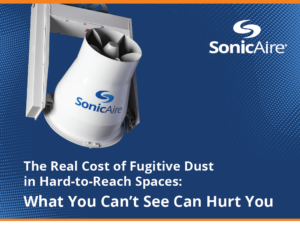
GET YOUR FREE GUIDE:
The Real Cost of Fugitive Dust in Hard-to-Reach Spaces
What You Can’t See Can Hurt You
To help protect your workplace, we’ve compiled the following resource, The Real Cost of Fugitive Dust in Hard-to-Reach Spaces: What You Can’t See Can Hurt You. In it, we identify seven ways fugitive dust is likely impacting your facility and its profitability.
These costs go beyond housekeeping and explain why you should be preventing dust buildup to protect the bottom line, not just to stay in compliance.

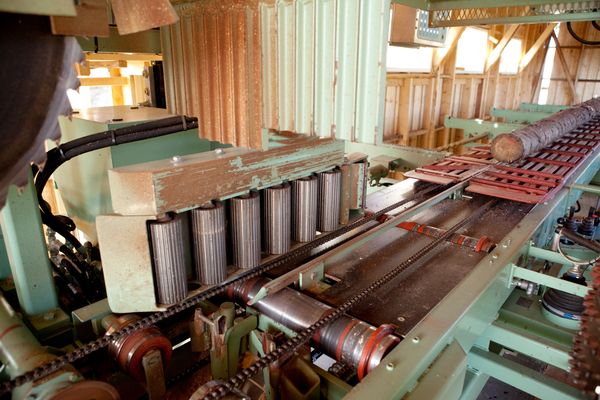 Three Factors that Determine Just How Many Fans You’ll Need
Three Factors that Determine Just How Many Fans You’ll Need